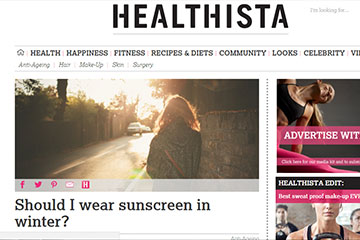
Should I wear sunscreen in winter?
DERMATOLOGY
Healthista
It’s grim outside and most of us probably don’t think about whether we should wear sunscreen in winter. So should we?
Dr. Noor Almaani, a consultant dermatologist at The Private Clinic responds to the question whether you need sunscreen during winter:
Yes. Sun protection should be a habitual part of the daily routine and ideally it should be practiced all year round.
Sunlight contains a spectrum of wavelengths, including visible and invisible light. Ultraviolet light forms part of the invisible spectrum of which, UVA and UVB reach the earth surface. UVA forms the majority of UV light and contributes to skin ageing and the development of skin cancer as it penetrates deeper into the skin (the main UV rays emitted by sunbeds). It has a consistent intensity throughout the day, all year round and can penetrate through cloud and glass.
UVB light is more intense and leads to the redness and sunburn that is indicative of some degree of DNA damage which in turn can potentially lead to genetic mutations and skin cancers. Its highest intensity is between 10am-4pm April-October. UV light also reduces the immunity in the skin and this can explain why, for example, some are prone to getting cold sores on sun exposure.
Therefore during winter, sun protection should still be practiced as cloud does not stop the penetration of UV light. You might get caught out on breezy ‘bright days’ when it doesn’t feel particularly warm but the UV index is still high and can still lead to skin damage.
The harmful effects of UV rays are cumulative and their longterm and irreversible effects might not be appreciated until many years later. These include increased skin ageing with reduced elasticity and wrinkle formation. It often leads to uneven pigmentation and lentigos (sun spots) as well as dark pigmentation over the forehead and cheeks (melasma). It can also lead to more visible ‘pores’ and can aggravate conditions such as rosacea. With significant sun damage premalignant crusty lesions (known as actinic keratosis) and atypical moles can appear that can potentially progress to skin cancers.
Some make ups and moisturisers have suncreen in them and the benefit of this is that it cuts out an additional step in your facial routine and thus might increase adherence to sun protection even when you are in a hurry. Having said that, it does not mean that you are fully protected particularly on warm sunny days. The SPF of sunscreens is measured using 2mg/cm2 but studies have shown that most of us use less than half that amount making the SPF which means we only end up getting a square root of what is written on the bottle (ie SPF 5 instead of 25).
To increase sun protection it’s best if sunscreens are applied 20 minutes before wearing clothes/going out, use a higher SPF and most importantly reapply sunscreens particularly when sweating and swimming. Ideally another layer should be applied an hour later for maximum effect and every few hours thereafter. The water resistance properties of some sunscreens can be reduced by prior application of moisturisers so they are best applied on their own if water resistance is to be maximised.
It is important to note that SPF in sunscreens refers to UVB protection whereas the star system found on the back of the tube or bottle refers to UVA protection (Ideally use SPF >35 for UVB and 5 stars for UVA). Don’t forget lip protection as sun damage and cancers can develop in this area.
Good sun protection ranges with good UVB/UVA coverage include the SunSense range, such as the SunSense Daily Face SPF50+ Invisible Tint Finish Sunscreen £15.49 from amazon.co.uk as well as Anthelios by La Roche Posay, such as the La Roche Posay Anthelios XL Face Ultra Light Fluid SPF 50 £16.50 from feelunique.com). Both include products for sensitive skin, tinted sunscreens, lip balms as well as a kids range. These can all be applied under makeup. Super city block by Clinique is a sheer product that offers UVA/UVB protection and can be used as a primer. Soltan by Boots also offers a wide and affordable affordable range for both kids and adults
Extra care should be taken when skiing as 80 per cent of UV rays can be reflected off the snow leading to higher UV exposure. In addition increasing altitude is associated with an increase in UV radiation. Therefore, although it might feel cold, sunburns can still happen and therefore reapplication of sunscreens is important.




